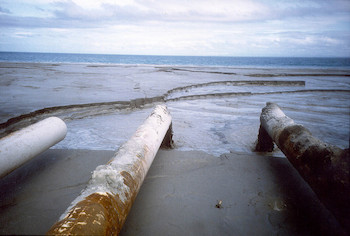Tailings

Tailings pipes from the Marcopper mine in Marinduque entering the sea at Calancan Bay. Credit: Catherine Coumans, MiningWatch Canada.
Tailings are a thick slush of waste materials left over after a mineral is extracted from ore. They consist of:
- Crushed rock
- Small quantities of metals
- Naturally occurring elements that are toxic when exposed to air, such as arsenic, mercury, sulfur and cadmium.
- Additives used in processing, such as petroleum byproducts, sulfuric acid and cyanide.
Tailings are usually stored in facilities on the surface, in ponds or in the form of piles or dry stacks. They are sometimes stored underground, by mixing the tailings with cement that fill “voids” in an underground operation. This mixture is known as backfill.
While backfill is generally considered safer, there is no foolproof way to store tailings. In August 2014, a tailings dam breach at Mount Polley Mine in British Columbia released 5 million cubic meters of toxic waste into nearby creeks and lakes. It is too he extent of damage from this tailings flooding, which will continue for another few weeks, cannot be determined. But this is not the first time that a tailings storage facility failed.
For example, in May 2011, a tailings dam for a silver mine in Turkey failed, requiring the evacuation of nearby residents. In 2000, a tailings dam in Baia Mare, Romania, burst, spilling 100,000 cubic meters of cyanide-contaminated waste into the nearby river system. The tailings made their way to the Black Sea, and killed a large number of fish in the process.
In some cases, mining companies do not even construct dams, impoundments or other facilities to contain tailings, but rather dump this mine waste directly into water bodies – including rivers, lakes and oceans.
In 2012, Earthworks and MiningWatch Canada released a report, Troubled Waters on aqueous tailings disposal. It found that each year, mining companies dump over 180 million tonnes of these hazardous mine wastes into rivers, oceans, and lakes - that's more than 1.5 times the amount of waste that US cities send to landfills each year.
The impacts of this practice are far-reaching. Tailings contaminate marine life with toxic heavy metals and milling chemicals. These metals and chemicals may build up in organisms up the food chain, and harm humans who eat fish found in these water bodies.
In addition, the dumping of this viscous mine waste causes turbidity (murkiness from suspended particles) and a smothering effect (cutting off the supply of water and oxygen) from the tailings that can kill marine life.
Rivers
The mining industry has made progress with riverine tailings disposal – most do not do this. This progress is significant, as tailings clog river channels and change their courses, cause floods, destroy vegetation and create obstacles to navigation. Tailings have smothered and flooded vast areas of wetlands and forests.
Tailings contaminate the water and the riverbed downstream with sediment, toxins and acid drainage that can persist for many decades after dumping ends. There have been instances of tailings filling entire lakes and spread over and smothered bottom life over vast stretches of large lakes such as Lake Superior.
Contamination can also spread from rivers to floodplains: in the Coeur d’Alene basin of Idaho, over 3,800 square kilometers of floodplain were contaminated and tailings toxins killed grazing livestock.
Mine wastes originally dumped into rivers have contaminated private drinking water wells and forced people to relocate their homes.
Case study - Lihir
The Lihir Gold Mine on the island of Aniolam has operated since 1997 and dumps over 5 million tonnes of tailings per year 1.5 kilometers offshore into the Luise Harbor and the South Pacific Ocean. The dumping has caused and marine life such as corals and low-lying fish to become less diverse and contaminated with mercury and arsenic. In spite of the demonstrated contamination and provincial government calls for regulation of the dumping, the mine, the mine increased production of gold and tailings in 2013.
Mine discharge
Tailings are not to be confused with mine discharges, which are a mix of water and chemicals that have been used for mineral extraction. Mine discharges often go through treatment before being released.
For more information:
Tagged with: tailings, mining, mine waste
Follow Earthworks